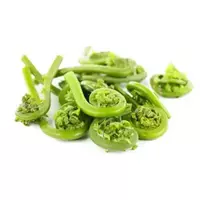Fern

The scientific name of this plant comes from pteron, which means "wing" in Greek, and aquila - "eagle" in Latin. Fern leaves in fact somewhat resemble the wings of a huge bird. As you know, the fern stalk grows underground, and in late spring, waiis begin to form - young leaves that initially look like a snail, and then, growing and unfolding, resemble a hook.
This plant has long been included in the diet of Far Eastern taiga, as well as residents of Korea and Japan. Today, domestic consumers are also showing interest in ferns as a food product. By the way, the protein content in ferns in its composition and properties is close to those in grain crops, and therefore this product is easily absorbed by the human body. The calorie content of fern, namely 100 grams of plant shoots, averages 34 kcal.
Different peoples of the world know and appreciate not only the useful properties of the fern, but also its gastronomic qualities. Based on shoots and young fern leaves, delicious salads are often prepared, and the "snails" themselves are boiled, fried, marinated and salted for the winter, and then used as a seasoning for meat. By the way, the cooked shoots of fern are somewhat reminiscent of mushrooms. However, remember that without heat treatment, ferns are not eaten.
Fern species
Today, it is customary to distinguish between about 300 genera and more than 10, 000 fern species. The most famous and notable in the forest is the eagle fern. It is it that is used for culinary purposes, and is also used to treat various diseases in alternative medicine.
Fern composition
It has been established that ferns (in particular, its rhizomes) contain substances such as saponins, alcoloids, starch, orlacotannyl and hydrocyanic acids, flavonoids, fat, essential oils and tannins. Meanwhile, young fern shoots are rich in vitamins, tocopherols, riboflavin, carotene and nicotinic acid.
Fern benefits
In medicine, the benefits of the eagle fern have long been known. This plant is effective for diseases of the spleen and intestine, for joint and diarrhea aches, head and thoracic pain, jaundice, dry pleurisy, for noise in the head and ears, and as a laxative, painkiller, worm and diuretic. Then it is recommended to use it orally in the form of a decoction of grass and rhizome of fern.
Fern harm
Nevertheless, it is advised to use infusions and decoctions of eaglet fern with great caution. The fact is that this plant is poisonous, and therefore the harm of fern to humans is quite likely. By the way, during pregnancy it is forbidden to use it at all.
fern 34 kCal
Energy value of fern (Ratio of proteins, fats, carbohydrates - ju):
Proteins: 4.55 g (~ 18 kCal)
Fats: 0.4 g (~ 4 kCal)
Carbohydrates: 5.54g (~ 22kCal)
Energy ratio (b | y): 54% | 11% | 65%
 Español
Español Français
Français Português
Português Русский
Русский 简体中文
简体中文 繁體中文
繁體中文 日本語
日本語 한국어
한국어 العربية
العربية Türkçe
Türkçe Қазақ
Қазақ Deutsch
Deutsch Italiano
Italiano Українська
Українська
